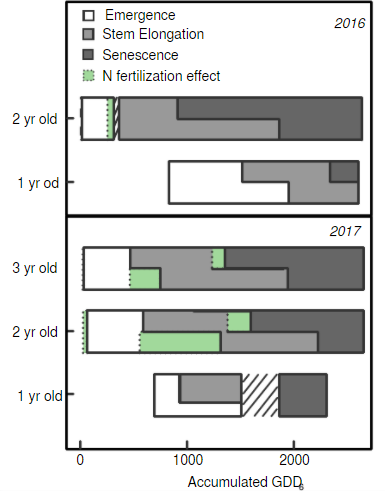Age-Related Changes in Miscanthus x giganteus Phenology and the Effect of Nitrogen Fertilization
Themes: Sustainability
Keywords: Biomass Analytics, Field Data, Phenomics
Citation
Tejera, M., Heaton, E. July 31, 2019, Data from: “The Older Plant Gets the Sun: Age-Related Changes in Miscanthus x giganteus Phenology” Mendeley Data. DOI: 10.17632/9rrfxshnm6.2.
Overview

Perennial plants go through noticeable morphological, developmental, and physiological changes as they age. Whether these age-related changes are driven by ontogenetic differences, are the result of different environmental conditions, or an artifact of plant size remains unknown. In this research we used the warm-season grass Miscanthus × giganteus as a model herbaceous perennial species to study age-related changes on phenology. Age-related experiments are usually based on field experimental design that confound growing season and age effects and ignore variability generated during the establishment of the stand. Here, we used a staggered-start experimental design where stands are repeatedly planted over subsequent years providing the ability to separate plant age effects from environmental effects. We hypothesized: (i) M. × giganteus would produce more plant structures and reach more advanced developmental stages in a given growing season as it aged; (ii) juvenile stands would have faster developmental rates and start development sooner; and (iii) mature stands would start senescence sooner in the growing season. Finally, we studied nitrogen (N) fertilization effects on M. × giganteus phenology as to assess whether age-related changes could be an artifact of size and N dilution in mature bigger individuals. We hypothesized that (iv) fertilized juvenile stands would have similar dynamics as mature unfertilized stands. Data were collected bi-weekly on all established stands during 2016 and 2017. Ten stems were harvested from each plot and staged at the lab according to M. × giganteus morphological scale developed by Tejera and Heaton (2017). Time series progression were then analyzed using non-linear models and parameters were compared across stand ages, N treatments and growing seasons. R scripts used to analyze the data are available upon request.